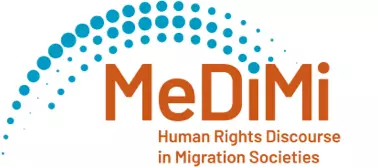Sub-project C.2
Dehumanizing, Victimizing, or Universalizing? How Images of Migration Interact with Human Rights Discourse
The project explores the claim that human rights discourse is becoming increasingly important in migration contexts (Vermenschenrechtlichung), as manifested in affective responses to visual and verbal images. Images of migration, such as the trope “Flüchtlingswelle” (a wave of refugees) transport pro- and anti-migration sentiments. The project maps out 1) how image topoi contribute to viewers’ subjective attitudes towards migration, and 2) how images function as platforms for viewers to exchange sentiments about human rights.
A three-part typology of images and their underlying narratives about migration is postulated to be similar in Germany’s and the United States’ “cultures of legality” (Olson 2022), despite their divergent migration policies and histories (Olson with Wessels 2020). The circumstances in which these image types have been disseminated during the post-‘crisis’ period, their framings, and their relations to specific migration-related events are documented through the analysis of major news sources and social media exchanges. One group of images dehumanizes persons to promote anti-immigration sentiments by comparing migrants to natural disasters such as tidal waves (“a tsunami of migrants”) or represents them as sexually violent predators (“Rapefugees”). A second type of image victimizes individuals to elicit sympathy for their suffering, while reifying their status as victims. A third group eschews gender clichés and racializing tropes. Depicted persons appear as individualized rights-holding subjects, as actors with the intrinsic and inalienable right to make legal and moral claims. The effects of the third type of image on affective relations to law and on the generalization of human rights discourse need to be explored. The project fills this research gap.
Based on the results of the analysis, the typology will be refined to account for sub-types of images and adjusted for anticipated differences in how the images impact on German and U.S. American legal environments. The project provides the theoretical basis for elucidating elements of the emergent human rights imaginary that MeDiMi proposes. This imaginary is transported through images and narratives to produce Rechtsgefühle – impassioned feelings about law, justice, and human rights. The project aims to increase media and political literacy by encouraging viewers to be self-reflective about interactions with depictions of migration and to note underlying narratives and tropes.
Principal Investigator: Prof. Dr. Greta Olson
Research Associates: Laura Borchert, Janina Schlüsselburg (associated)
Justus Liebig University Giessen
